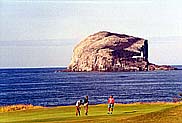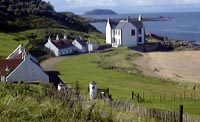

COVENANTER PRISON
View of Bass Rock
 from the
coast.
from the
coast.
Some of the cottages
 to be seen on it.
to be seen on it.
After the castle was converted into a State Prison
during the reigns of Charles ll and his brother James Vll, a number of
Covenantors were imprisoned there at a time of tyranny and persecution. The
Covenanters rebelled against Charles's obsession for a change from
Presbyterianism to his Roman Catholic style religion. After a violent struggle
against the crown the Covenantors were finally defeated at the Battle of
Sheriffmuir when 1,800 of them were brought to Edinburgh to stand trail. A
section of Greyfriars graveyard was used as their prison when hundreds were
deported and over 130 executed. About forty were incarcerated in the dungeons
of the Bass Rock at different dates, varying from a few months to
upwards of six years.
Most of them men of culture and learning, of
unimpeachable loyalty and charged with no offence but that of preaching the
gospel and worshipping according to their own consciences. These included John
Blackadder, minister at Tragueer in Dumfries. Blackadder died on the rock in
1687 and is buried in the Churchyard at Kirk Ports. Among the other Covenantors
imprisoned on the Bass by the Duke of Rothesay, then Lord Chancellor were
Alexander Peden, Thomas Hogg, James Fraser of Brea, Robert Traill and John
McGilligen, all of them ministers. Sir Hugh Campbell of Cessnock, and his son
Sir George Campbell; Robert Bennett of Chesters and Alexander Gordon of
Earlston.
The barbarity of life in the State Prison was beyond credibility.
The prisoners unable to support themselves were kept on a diet of dried salt
fish and only the guards had barrelled fresh water. The prisoners depended
solely upon rock puddles for water so putrid that for a little more
palatability they sucked it through porridge oats. In bad weather they starved
until calmer seas allowed boats to land provisions and at the whim of the
governor, a hated prisoner was confined in the lowest dungeon which was deathly
cold from continuous sea spray. Those who did not perish in its vile and
stinking cells suffered and died later from lung infections, fevers or
rheumatic type ailments as freed men.
One who did survive was the minister
Gilbert Rule whose imprisonment was brought to an end by the Revolution of 1688
and later was appointed Principal of the University of Edinburgh. Whitekirk
Hill overlooking the Bass Rock was the site of a Covenantors Meeting on Sunday
5th May 1678 when a crowd of over one thousand assembled for the worship of
God. The governor of the Bass, Charles Maitland, with sixty soldiers from the
garrison, marched to attack and disperse them. As the soldiers approached,
James Learmont a chapman or travelling merchant from Haddington exhorted the
people to stand firm and defend themselves if attacked. The soldiers ordered
the crowd to dismiss in the King's name; where upon they replied that 'they
honoured the King, but were resolved to hear the word of God when preached to
them.' A scuffle ensued and the soldiers were surrounded and disarmed, one of
them being shot dead. Five of the Covenantors were apprehended and tried before
the Privy Council in Edinburgh on 11th September 1678. James Learmont was found
guilty and executed in the Grassmarket on 27th September 1678. He was guilty of
nothing but worshipping the God of his fathers according to his conscience and
his treatment at the hands of the arbitrary tyrants who then oppressed the
country, outraged the population.
In 1688, most of the Covenantors we
released when James VII was relieved of his Crown and William of Orange was
proclaimed King. The majority of the country continued to be faithful to James
until the Battle of Killiecrankie, after which the only Jacobite stronghold was
on the Bass Rock. Where a handful of Jacobites held out for two years
under the pro-stuart Governor Charles Maitland until they were starved into
submission in 1690. The following year it was the Jacobites again who turned
the tables on their captors when the new Governor, Fletcher of Saltoun was
absent, by locking out the guards while they were unloading coal at the jetty.
The guards had to be taken off by boat; the Jacobites - just four of them
initially - managed to hold out for four years.
During this period various
attempts were made by the Government of King William to retake the fortress,
but in vain. Friends in France and in Scotland kept them supplied with food,
and as they had plenty of ammunition, they defied all comers. It had been found
that a man called Trotter was secretly supplying them with provisions. To
terrorise them, preparations were made for hanging Trotter on the shore
opposite the island. The defenders, however would not stand this, and a few
well aimed cannon balls promptly dispersed the would-be executioners, and
Trotter had to be hanged elsewhere out of sight. In 1694, William dispatched
two warships, aided by smaller vessels to cut off all supplies to the rock and
the little garrison capitulated in April. They had saved some bottles of the
best French wine and these, along with some fine biscuits, led the
commissioners to believe that they had provisions for years to come. Thus the
rebels - eventually 16 in all - were able to negotiate good terms and were
finally granted an amnesty.
Home | Links | Photos | Hall | Writings | Biography